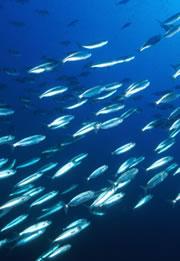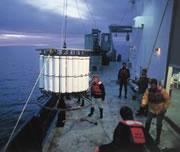 Fishing leaves the little ones behind.Alamy
Fishing leaves the little ones behind.AlamyFishing makes fish populations more variable from year to year, and so more vulnerable to complete collapse, says a study in Nature this week.
These 'boom and bust' cycles are probably amplified by fishermen targeting the stronger, bigger, older fish, the international research team says. So quota-setting agencies should consider adjusting fishery takes to protect larger fish, they advise.
For decades, researchers have examined the rise and fall of certain fish populations, trying to determine why the numbers changed: excessive fishing, ocean temperature shifts, or some combination of these factors have been blamed. Fishing-industry groups often laid the blame for plunging populations on environmental change.
To decipher the cause, George Sugihara and Chih-hao Hsieh from the Scripps Institution of Oceanography in La Jolla, California, and their colleagues looked at a more-than-50-year data set of fish larvae counts for both targeted and non-targeted species of fish.
The data come from the California Cooperative Oceanic Fisheries Investigations (CalCOFI), which was initiated in 1949 in the days after the collapse of the sardine fishery (as made famous by American author John Steinbeck). The survey includes long-term samples and oceanographic data from the tip of Baja California in Mexico to British Columbia in Canada, though in recent years the data have been limited to surveys primarily in waters between San Diego and San Francisco.
The group looked at the data for both 13 targeted species — such as Dover sole (Microstomus pacificus) and Pacific sardines (Sardinops sagax) — and 16 species that are usually left unharassed by industry, such as smalleye squaretail (Tetragonurus cuvieri) and basketweave cusk-eel (Ophidion scrippsae).
Ups and downs
 CalCOFI researchers have been collecting data since 1949.Scripps Institution of Oceanography/UC San Diego
CalCOFI researchers have been collecting data since 1949.Scripps Institution of Oceanography/UC San DiegoLarvae abundance varied much more from year to year in the targeted species than in the non-targeted ones, they report. In a low year, fish populations are more vulnerable to total collapse should another factor — from lack of food to changing water temperatures — tip them over the edge. "Fishing can cause a greater risk of collapse than we previously thought," says Sugihara.
"They show that exploited populations are clearly more vulnerable than unexploited populations," agrees biologist Roger Hewitt, director of fishery resources at the Southwest Fisheries Sciences Center (National Marine Fisheries Service, NMFS) in La Jolla, who wasn't involved in the research.
The researchers say that the selective catch of older, larger fish, which can be stronger reproducers and more adept at surviving environmental change, is probably the cause. The group examined records for landings of targeted fish, and found that samples of all the species declined in size and age over time, with 9 of the 13 dropping significantly.
Big fish, little fish
The average length of Dover sole, for example, dropped from 40 to 37 centimetres between 1970 and 2004. This is the equivalent of a typical American male shrinking 15 centimetres. The average age of this fish declined from 16-18 years in the 1980s to 12-13 years by 2005.
ADVERTISEMENT
The study authors say policy-makers should reassess fish-catch quotas in light of these results, looking to manage the age and size of a particular species caught; not just the overall landed weight. "These results really make a strong case for marine protection reserves to maintain such fish stocks," says Sugihara.
The NMFS, which works with regional councils to set quotas in the US ocean zone, was contacted by Nature for comment on policy issues, but did not reply.
Visit our thebig_fish.html">newsblog to read and post comments about this story.
-
References
- HsiehC. H., et al. Nature, 443 . 859 - 862 (2006). | Article |
